Like the deep sided valley across which it is haphazardly strewn, Medellín has had its ups and downs. The city that results is a remarkably cultured one offering a huge variety of activities and experiences. If anything, spending three days there might not be enough.
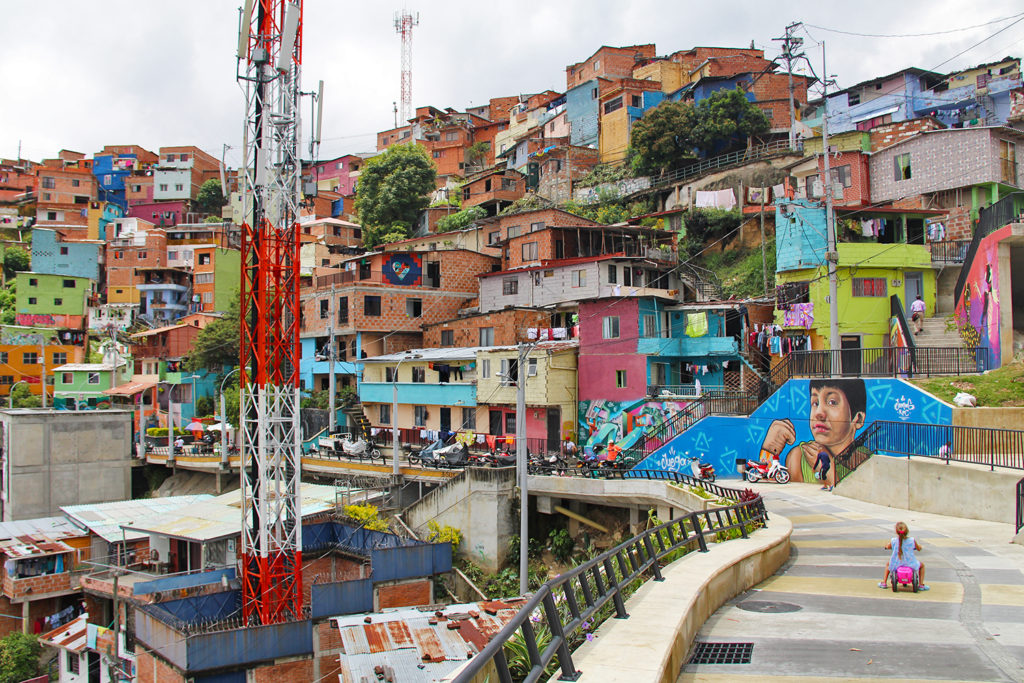
Colourful Comuna 13 (Photo: Paul Stafford)
Hope is the key word for a city like Medellín, whose nickname is “the city of eternal spring.” If you arrive in Medellín from the coast, Cartagena, for example, the feeling of the cooler mountain air is immediately endearing. The city spills down steep valley sides in a terracotta melee of shanties and high-rises. Cable cars and the expanding metro system are opening the city up to tourism and connecting barrios that would have felt removed and dangerous previously.
There is something else that also makes its presence felt on arrival, and that is the sense of individuality and freedom in the way people dress. All manner of styles and fashions are on show in Colombia’s second biggest city. Freedom of expression underpins a lot of what makes the city so unique, and this can be witnessed everywhere: the engorged sculptures of Fernando Botero show a playful side, while the murals and painted facades of Comuna 13 allude to a conscious, collective move towards a more positive community spirit, away from the negativity of the past.
The past is something that cannot escape mention in any Medellín-focussed travel literature. Practically every travel story in every major newspaper about the city will hone in on the fact that twenty years ago, Time Magazine branded Medellín “the most dangerous city in the world.” While that is more of a gimmicky title than anything, it is certainly a cloud over the city and many locals are vocal about preferring tourists to focus on more than just violence, Pablo Escobar and cocaine.
But it’s a tough issue, and at the time of writing, the notorious 13th District of the city has experienced a surge in violence between paramilitary groups – fed by the narcotics industry – and the military. True, this may be the safest time to visit Medellín since the 1970s, but the word safe is relative for most travellers.
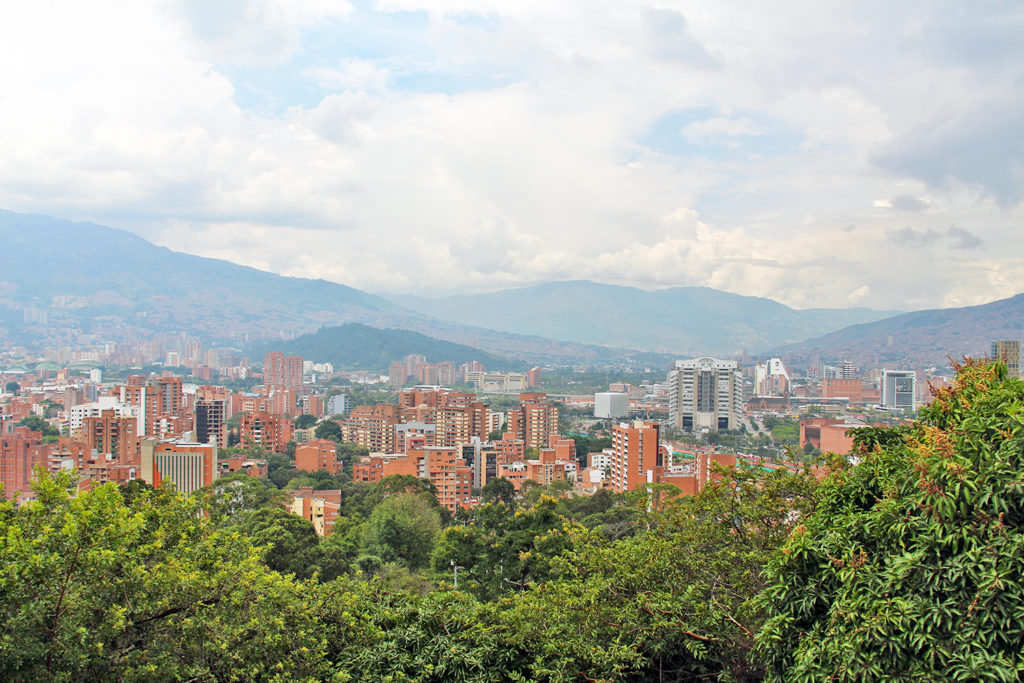
Medellin from Pueblito Paisa (Photo: Paul Stafford)
The legacy of Pablo
So, let’s get past the elephant in the barrio. Pablo Escobar was once the proud son of Medellín, and to this day he remains an enigma, inseparable from the city. In his early days, he posed as something of a Robin Hood for poorer citizens of Medellín. He was generous with his money, giving regularly to the local community. With hindsight however, this was a classic ploy of his, and a way of growing his influence. The Medellín Cartel bought so many people off that Escobar became so untouchable he was able to run for Congress in 1982, which demonstrated how he wanted to sew up the entire system in his favour.
When the backlash came, it instigated a complex and bloody war between Escobar and the state that then gave rise to paramilitary groups, militias and other drug cartels, which stepped into the gaps left by Escobar. The drug industry was so chaotic for Colombia and Medellín that they are just now recovering to something resembling a pre-1982 point.
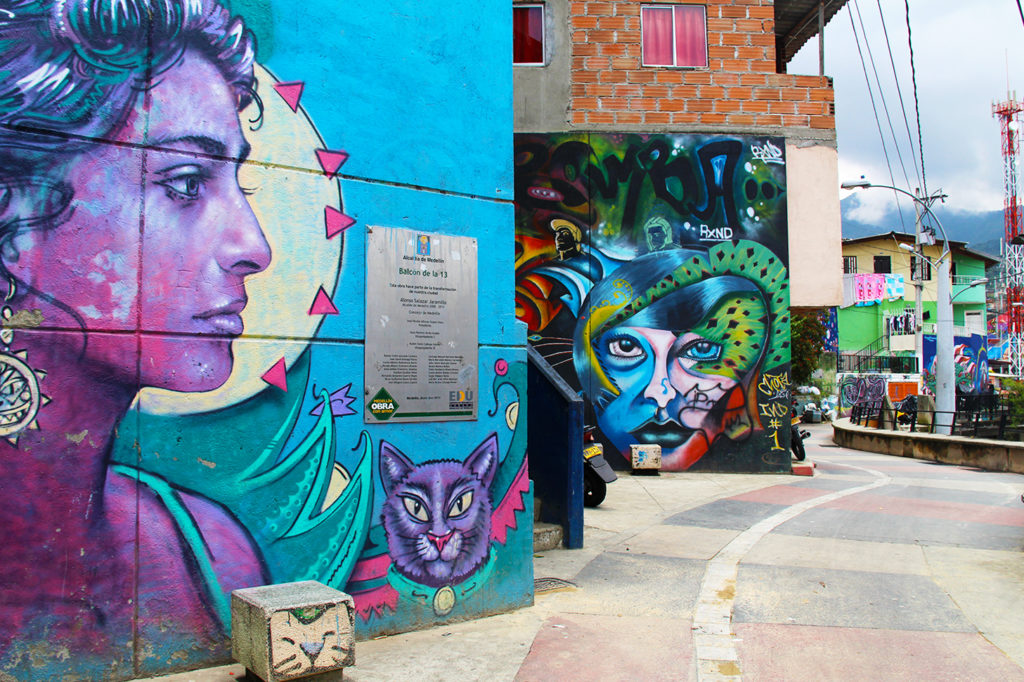
Murals in Comuna 13 (Photo: Paul Stafford)
Painting over it all
A perfect example of where Medellín has managed to move on is Comuna 13 in the north-west of the city. Once the locus for much of the crime and murder, Medellín’s poorest neighbourhood exemplifies the innovation that has pulled the city back onto its feet. The whole area is covered in bright murals and every building is painted in bold colours. The elevation of the neighbourhood offers great views, but the key to its rejuvenation was the construction of a series of escalators that take people to the top. Around this area, locals have been able to start their own businesses aiming at the tourism and therefore attracting more wealth. It is a great place to spend all, or part of a day.
From San Javier, the closest metro station, you can also take a cable car over mountains and back down into valleys, seeing parts of the city that were once inaccessible to outsiders. You also experience the sounds too, as strains of Latin music, sirens and people talking all sift up from the neighbourhoods as you pass overhead.
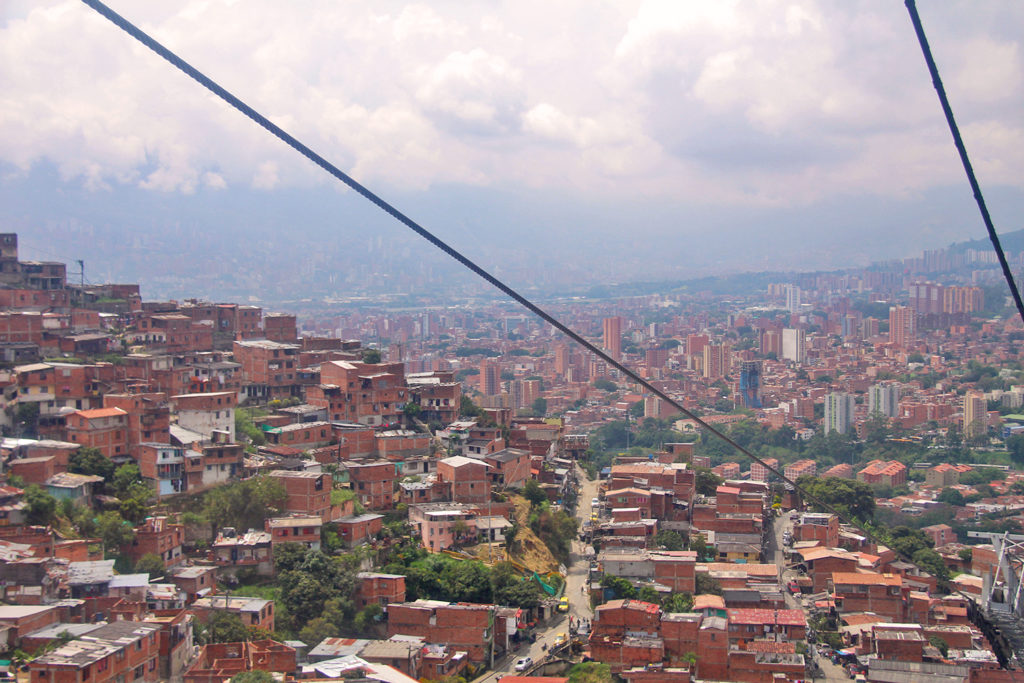
The sprawling city of Medellin from the cable car (Photo: Paul Stafford)
Popular sights
Downtown, along the Medellín River, much of the historic side of the city unfolds. Pueblito Paisa showcases what traditional villages in across the Antioquia region look like. The Museo de Antioquia gives much more insight into the region, as well as exhibiting much of Botero’s idiosyncratic artwork. Meanwhile El Poblado represents the modern side of the city, which tends to attract a lot of the tourists with its mix of hostels and upscale hotels. This area of the city is more peaceful and wealthier than the rest of Medellín, but lacks the same originality found elsewhere.
When the city gets too cloying, there are excellent open spaces to which you can retreat. Downtown, Joaquín Antonio Uribe Botanical Garden is a must. Further afield, take the vertiginous cable car up and away from Acevedo station to the heights of Parque Arví, which appears after a seemingly endless ascent, up and out of the city and valley. This is a great place to cycle and hike, but it is best to give yourself an entire day to explore it properly.
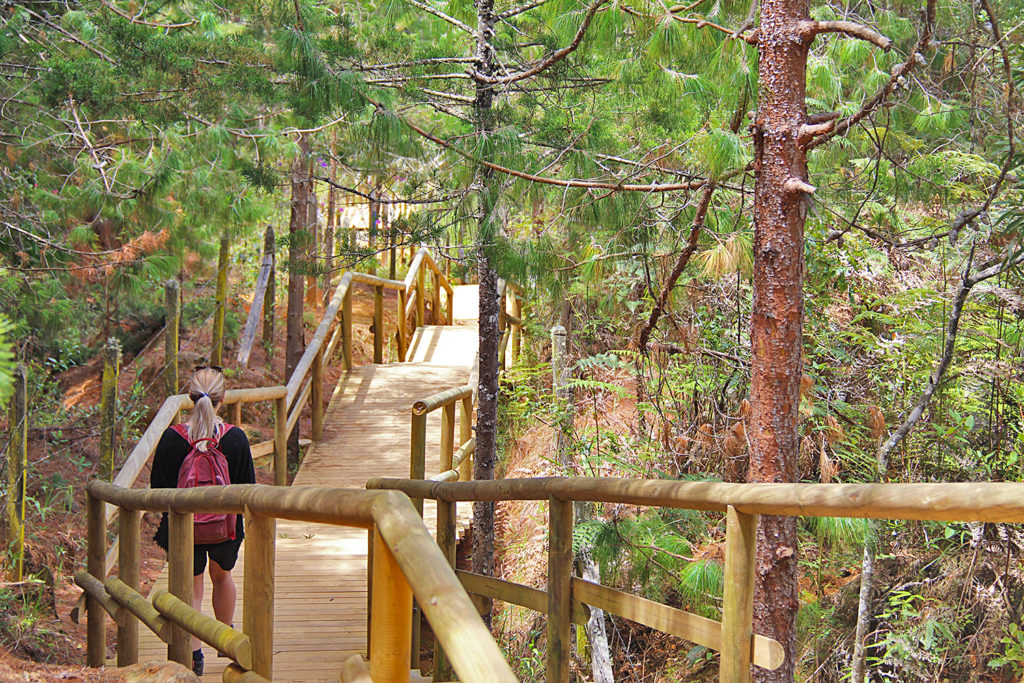
A wooden walkway in Parque Arvi (Photo: Paul Stafford)
Medellín’s true calling reveals itself from dusk onwards: Nightlife. Depending on the kind of music and experience you prefer, there are a couple of great choices for a night out. El Poblado has the high-end clubs at night, and by day is packed with beer bars and restaurants. For a more authentic night out however, Carrera 70, running south of Estadio metro station is lined with great discos and clubs playing salsa and other forms of tempo-raising rhythms.
Responsible travel
There are plenty of people who come to Colombia thinking they are going to find cheap thrills and cheaper cocaine. And they just might. But bear in mind that the pain and torment felt across Colombia for decades (and still today), only just starting to abate, is fuelled by that kind of infantile tourism. You cannot buy drugs in Colombia and have clean hands when it comes to the anguish that results from conflict between rival drug gangs here. It’s as simple as that.
Accommodation
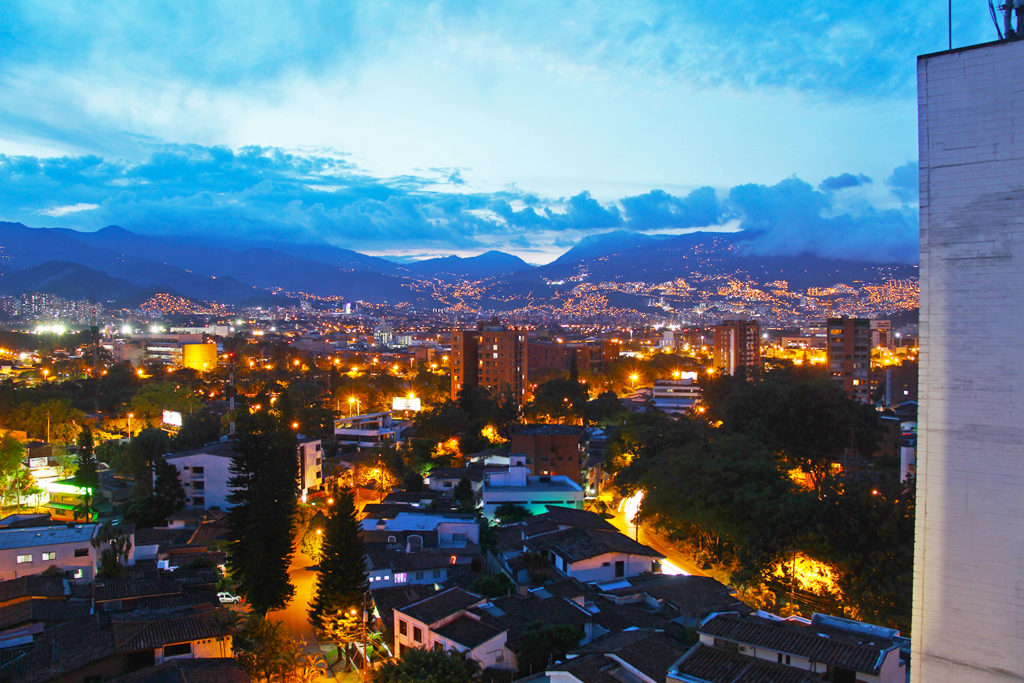
View from the roof of Sites Hotel (Photo: Paul Stafford)
Like any big city, Medellín has hundreds of options for spending the night across an entire spectrum of needs. Sites Hotel (Carrera 45, no. 5) is one of the great five-star hotels in El Poblado, where many of the visitors from overseas tend to end up. The high-rise hotel sits in a quiet area between Poblado metro station and the main street of the neighbourhood. The rooftop pool and seating areas offer magnificent vistas of the city, particularly at night. The hotel has a good library, a popular buffet breakfast in the mornings and the rooms are huge and have excellent rainforest showers.
A great budget option for anybody who prefers to stay away from the more touristy parts of the city, while still being right in the thick of things, is Hostal Cattleya Medellin (Carrera 69, no. 44B). Located a couple of blocks over from Carrera 70, a great nightlife spot, Cattleya Medellin is on a quiet road that benefits from the general security and affluence to be found around Estadio metro station. It is well connected to the rest of the city, being just a couple of metro stops from the historic centre. The hostel is basic and clean and has a shared kitchen and a terrace with hammocks.
BlackPine Hostel (Carrera 47a, No. 5) is a little way out of the hubbub of El Poblado, within easy walking distance of the Poblado metro station. This is a popular area with tourists and so a well-regarded hostel like BlackPine can get booked up in advance. There are small dorms (of up to seven beds) and private rooms available, all of which have a basic, free breakfast included in the price. The hostel has an on-site coffee shop and a communal kitchen and garden. This is a good hostel for meeting other travellers.
If it is a little extra leg room that you want, Travelers Orange Suites (Calle 8, no. 43C) provides huge open suites that are partitioned into a kitchen, sitting room and bedroom, along with a separate bathroom. The kitchens come complete with fridge and a hob on which to cook. The rooms have plenty of amenities. Beds are large and there is a flat-screen TV either in the bedroom or sitting room of each suite. Additionally, there is a small rooftop space with sun loungers for guests and a buffet breakfast with an omelette bar each morning.
Restaurants and Cafes
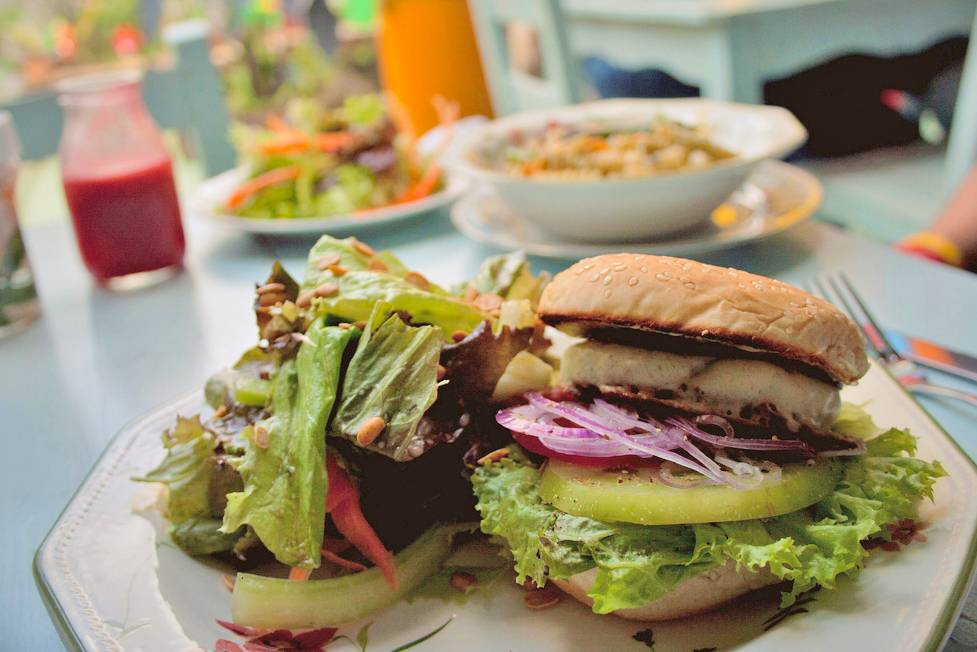
Veggie burgers at Verdeo (Photo: Colores Mari via Flickr)
For anybody travelling extensively through the region who does not eat, or is tired of eating, meat, Medellín has a great range of health food, vegetarian and vegan-friendly places to eat. Verdeo (Calle 12, no. 43D-77) is one of the best of these, and proof that meat is just an ingredient. Wraps, burgers, quesadillas and even pasta dishes accompany many other meat-free offerings, like falafel, hummus and salads. Presentation and recipes are creative and delicious. They also sell cake.
The act of trying to find a good place to eat or grab a coffee can be overwhelming in a big city like this. Narrowing down the options to one takeaway list is nigh on impossible. However, we must all start somewhere and an excellent choice for authentic local cuisine is Hacienda (La Strada, Avenida El Poblado, Local 225). Now a chain of four different restaurants, the focus here is on home-cooked style food with a rustic, Antioquian twist. That means chorizo empanadas with fried potato, arepas and yuca all make regular appearances in various guises on the menu.
An excellent choice for the health-conscious is Naturalia Café (Circular 3, no. 70-39). Rooted close to Calle 70, Naturalia serves up excellent coffee, and healthy juices and smoothies. There is a small menu, with items including sandwiches and salads, most of which are suitable for vegetarians with plenty of vegan-friendly choice as well. It is also a great place to spend a cultured evening, and regular events include craft beer or wine tastings, open mic nights and the occasional gig.
For a top-end meal, check out Carmen Restaurante (Carrera 36, no. 10A-27), founded by two graduates of the prestigious Le Cordon Bleu in San Francisco, who then moved to Medellín to start this restaurant. The menu features flair and creativity, for example their Trifásico is a confit of pork cheek, beef neck, chicken, and quail egg, among other ingredients. Most of the mains consist of meat or fish, although there is a vegetarian option too.
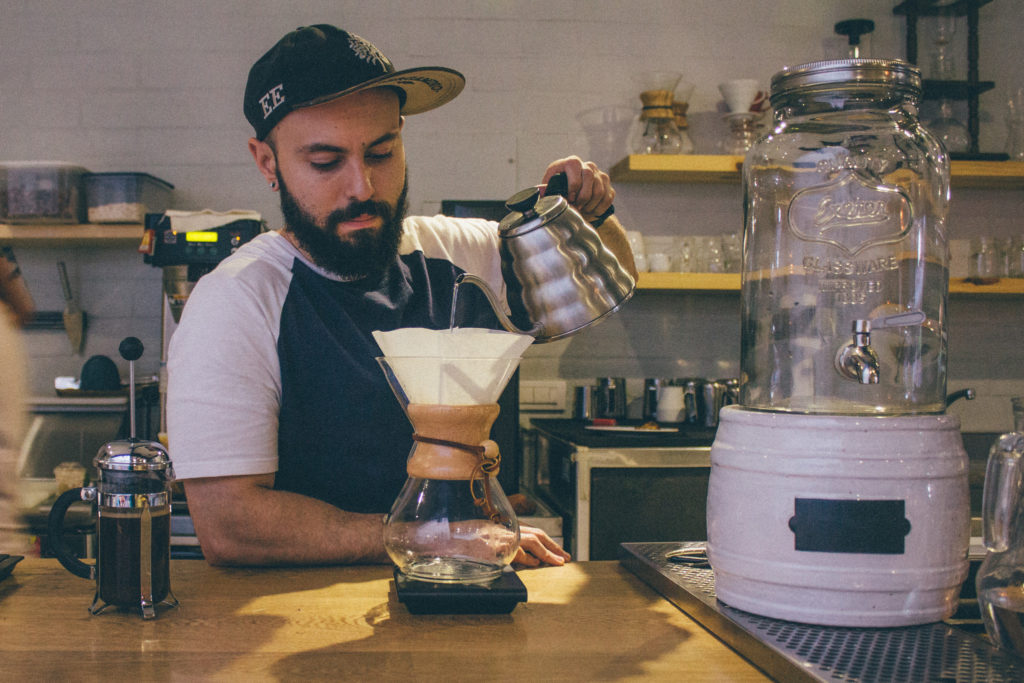
Cafe Pergamino (Photo: MDE Ciudad Inteligente via Flickr)
Café Pergamino (Carrera 37, no. 8A-37), in the centre of Poblado near the central square of Lleras Park, is the place to go for authentic Colombian coffee. They serve up top-notch, freshly-roasted coffee that is specially selected from local farms. The brand has continued to grow in recent years because of this popularity and they now also export freshly-roasted coffee beans to customers across North America. But the best brew will always be local, close to the source, which is why their Poblado branch is a great shout.
Nightlife
A couple of regions in Medellín are highly regarded for their nightlife, but the vibe in each is very different. El Poblado has fast become the more well-heeled and international place for a night out, but it does feel a little restrained when compared to Carrera 70, which is far more popular with local Paisas.
When in Colombia, making dancing a priority will put you in good company. There are some great salsa clubs in Medellín, and Eslabón Prendido (Calle 53, no. 55) is generally considered to have some of the best live salsa in the city. But that does mean that you will generally be dancing in a crowded small space. Bear in mind also that the location is down a small side-street and it is best reached by taxi. The live music only gets going after 10pm.
At Envy Rooftop (Calle 9a, no. 37-16), envy is about right where other bars are concerned, because the location and setting are unbeatable. There is a pool, but that is sometimes covered by a stage for live music. The drinks are excellent and complemented by a good menu, including things like sushi rolls, and the view out over the city at night, with the expanse of lights dotted up the sides of the valley make for a unique night out.
Reggaeton practically sets a beat for the entire country and you’ll rarely hear western songs that deviate from it outside of El Poblado when in Medellín. However, even in Poblado it’s the preferred music of choice at many of the best clubs, one of which is Babylon (Carrera 49, no. 9-22). There’s often a cover charge at the door, but that frequently leads to an open bar on Thursdays and Fridays, while Saturdays often mean no cover to enter, but a longer wait to get inside.
One of the more popular clubs with the university crowds of Medellín is California Club (Avenida 33, no.78-29). Having been around for quite some years, it is popular for both the music and cheap drinks on offer. This is certainly a good choice if you want to avoid the more touristy spots of El Poblado. The club is located in the west of the city, further out along Avenida 33 from the Pueblito Paisa and is only open on weekends.
Shopping
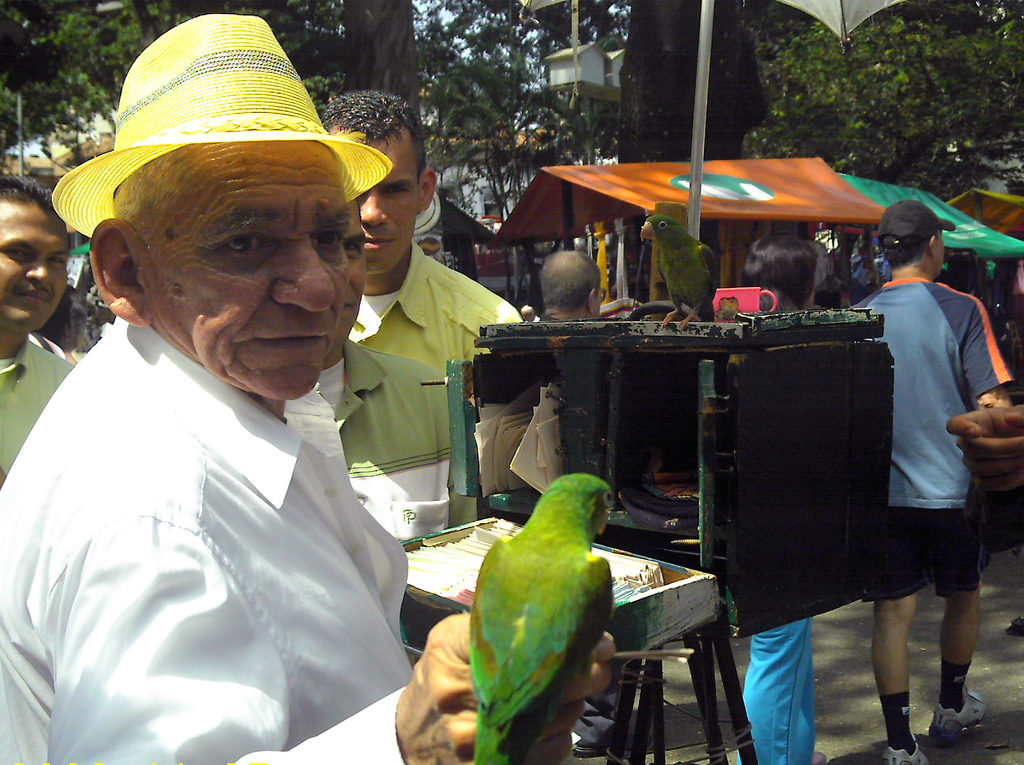
A good luck bird, San Alejo market (Photo: medea_material via Flickr)
Medellín is a fantastic place to pick up souvenirs from your time in Colombia. There is a good mix of smaller stores and plenty of artisanal markets, such as San Alejo Craft Market (Parque Bolivar), which takes place just once a month, on the first calendar Saturday. It might sound infrequent, but up to 500 specialists turn out to sell their wares, including woodcarvers, jewellers and weavers. As with much of the region, haggling is not unheard of, but it’s also not advised to do it with anything other than the spirit of fun.
For a good souvenir shop located in El Poblado, check out Colombia Mía (Calle 10, no. 34-39). Items on sale include clothing, with a number of city-themed t-shirts and handmade items like Colombian flag-coloured bracelets. Bags, mugs and various other standard souvenir curios are on sale. You can also get yourself a good hammock. It’s worth keeping in mind that the tighter a hammock’s weave, the better the quality and comfort.
If you are about to leave Colombia and are in a panic because you’ve just remembered you haven’t picked anything up for your family, then Artesanías Caballo de Troya (km 16, Las Palmas) might just be your lifeline. This remote giftshop is roughly midway between the city and Medellín’s main airport, making it ideal for a last-minute stop without having to pay airport prices. There is a lot of choice here from wider Colombia, as well as crafts from Antioquia.